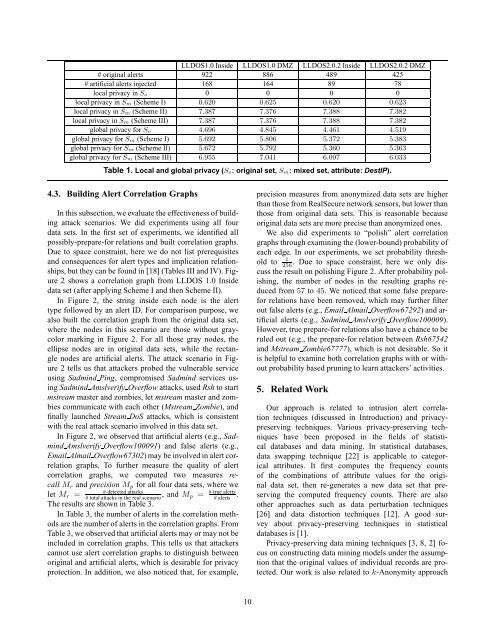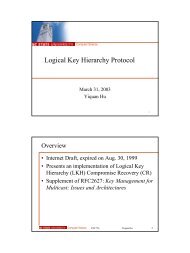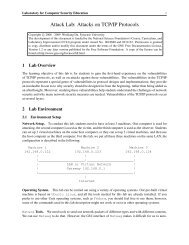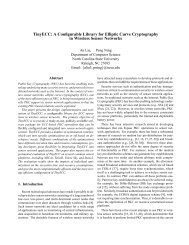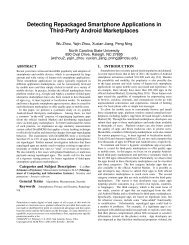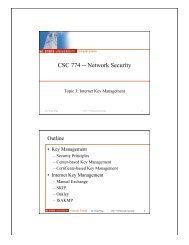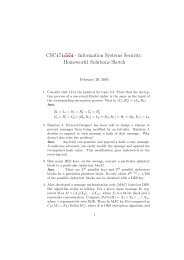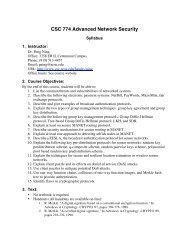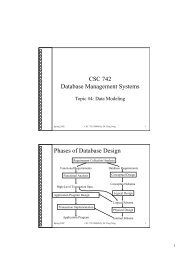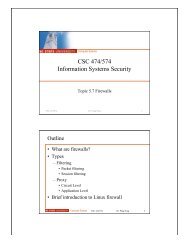A Flexible Approach to Intrusion Alert Anonymization and Correlation
A Flexible Approach to Intrusion Alert Anonymization and Correlation
A Flexible Approach to Intrusion Alert Anonymization and Correlation
You also want an ePaper? Increase the reach of your titles
YUMPU automatically turns print PDFs into web optimized ePapers that Google loves.
LLDOS1.0 Inside LLDOS1.0 DMZ LLDOS2.0.2 Inside LLDOS2.0.2 DMZ<br />
# original alerts 922 886 489 425<br />
# artificial alerts injected 168 164 89 78<br />
local privacy in S o 0 0 0 0<br />
local privacy in S m (Scheme I) 0.620 0.625 0.620 0.623<br />
local privacy in S m (Scheme II) 7.387 7.376 7.388 7.382<br />
local privacy in S m (Scheme III) 7.387 7.376 7.388 7.382<br />
global privacy for S o 4.696 4.845 4.461 4.519<br />
global privacy for S m (Scheme I) 5.692 5.806 5.372 5.383<br />
global privacy for S m (Scheme II) 5.672 5.792 5.360 5.363<br />
global privacy for S m (Scheme III) 6.955 7.041 6.097 6.033<br />
Table 1. Local <strong>and</strong> global privacy (S o: original set, S m: mixed set, attribute: DestIP).<br />
4.3. Building <strong>Alert</strong> <strong>Correlation</strong> Graphs<br />
In this subsection, we evaluate the effectiveness of building<br />
attack scenarios. We did experiments using all four<br />
data sets. In the first set of experiments, we identified all<br />
possibly-prepare-for relations <strong>and</strong> built correlation graphs.<br />
Due <strong>to</strong> space constraint, here we do not list prerequisites<br />
<strong>and</strong> consequences for alert types <strong>and</strong> implication relationships,<br />
but they can be found in [18] (Tables III <strong>and</strong> IV). Figure<br />
2 shows a correlation graph from LLDOS 1.0 Inside<br />
data set (after applying Scheme I <strong>and</strong> then Scheme II).<br />
In Figure 2, the string inside each node is the alert<br />
type followed by an alert ID. For comparison purpose, we<br />
also built the correlation graph from the original data set,<br />
where the nodes in this scenario are those without graycolor<br />
marking in Figure 2. For all those gray nodes, the<br />
ellipse nodes are in original data sets, while the rectangle<br />
nodes are artificial alerts. The attack scenario in Figure<br />
2 tells us that attackers probed the vulnerable service<br />
using Sadmind Ping, compromised Sadmind services using<br />
Sadmind Amslverify Overflow attacks, used Rsh <strong>to</strong> start<br />
mstream master <strong>and</strong> zombies, let mstream master <strong>and</strong> zombies<br />
communicate with each other (Mstream Zombie), <strong>and</strong><br />
finally launched Stream DoS attacks, which is consistent<br />
with the real attack scenario involved in this data set.<br />
In Figure 2, we observed that artificial alerts (e.g., Sadmind<br />
Amslverify Overflow100091) <strong>and</strong> false alerts (e.g.,<br />
Email Almail Overflow67302) may be involved in alert correlation<br />
graphs. To further measure the quality of alert<br />
correlation graphs, we computed two measures recall<br />
M r <strong>and</strong> precision M p for all four data sets, where we<br />
# detected attacks<br />
# true alerts<br />
# alerts<br />
.<br />
let M r =<br />
# <strong>to</strong>tal attacks in the real scenario , <strong>and</strong> M p =<br />
The results are shown in Table 3.<br />
In Table 3, the number of alerts in the correlation methods<br />
are the number of alerts in the correlation graphs. From<br />
Table 3, we observed that artificial alerts may or may not be<br />
included in correlation graphs. This tells us that attackers<br />
cannot use alert correlation graphs <strong>to</strong> distinguish between<br />
original <strong>and</strong> artificial alerts, which is desirable for privacy<br />
protection. In addition, we also noticed that, for example,<br />
precision measures from anonymized data sets are higher<br />
than those from RealSecure network sensors, but lower than<br />
those from original data sets. This is reasonable because<br />
original data sets are more precise than anonymized ones.<br />
We also did experiments <strong>to</strong> “polish” alert correlation<br />
graphs through examining the (lower-bound) probability of<br />
each edge. In our experiments, we set probability threshold<br />
<strong>to</strong><br />
1<br />
256<br />
. Due <strong>to</strong> space constraint, here we only discuss<br />
the result on polishing Figure 2. After probability polishing,<br />
the number of nodes in the resulting graphs reduced<br />
from 57 <strong>to</strong> 45. We noticed that some false preparefor<br />
relations have been removed, which may further filter<br />
out false alerts (e.g., Email Almail Overflow67292) <strong>and</strong> artificial<br />
alerts (e.g., Sadmind Amslverify Overflow100009).<br />
However, true prepare-for relations also have a chance <strong>to</strong> be<br />
ruled out (e.g., the prepare-for relation between Rsh67542<br />
<strong>and</strong> Mstream Zombie67777), which is not desirable. So it<br />
is helpful <strong>to</strong> examine both correlation graphs with or without<br />
probability based pruning <strong>to</strong> learn attackers’ activities.<br />
5. Related Work<br />
Our approach is related <strong>to</strong> intrusion alert correlation<br />
techniques (discussed in Introduction) <strong>and</strong> privacypreserving<br />
techniques. Various privacy-preserving techniques<br />
have been proposed in the fields of statistical<br />
databases <strong>and</strong> data mining. In statistical databases,<br />
data swapping technique [22] is applicable <strong>to</strong> categorical<br />
attributes. It first computes the frequency counts<br />
of the combinations of attribute values for the original<br />
data set, then re-generates a new data set that preserving<br />
the computed frequency counts. There are also<br />
other approaches such as data perturbation techniques<br />
[26] <strong>and</strong> data dis<strong>to</strong>rtion techniques [12]. A good survey<br />
about privacy-preserving techniques in statistical<br />
databases is [1].<br />
Privacy-preserving data mining techniques [3, 8, 2] focus<br />
on constructing data mining models under the assumption<br />
that the original values of individual records are protected.<br />
Our work is also related <strong>to</strong> k-Anonymity approach<br />
10


